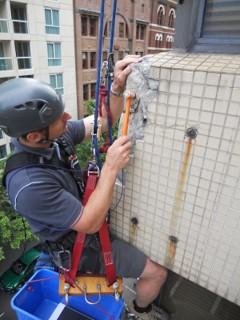Case 1
- Introduction
- Causes of Defects
- Good Practices
- Standards
- Maintenance and Diagnostics
- Remedial
- Similar Cases
- References
Maintenance and Diagnostics
Maintenance
In general, good quality concrete does not require extensive maintenance. However, due to external factors it might have some defects even before reaching its design life.
Regular inspections and checking should be hence carried out periodically at regular intervals to detect these defects and to take remedial action to remove these defects. An efficient inspection system should be adopted to ensure the conduct of regular checks such as visual inspections periodically.
Suitable instruments and techniques should be used to diagnose defects properly. Diagnosis involves a process in which experts investigate the buildings’ conditions, carry out tests, evaluate, make recommendations for remedial actions where necessary and predict the future performance of a building.
Even the best masonry requires periodic maintenance to ensure its continued successful performance.
Although the brick units are quite durable over time, other materials in the wall system will require periodic repair and/or replacement.
Typical maintenance items which should be addressed are repairing of cracks in masonry, cleaning clogged weepholes, removing stains and efflorescence, repainting steel, replacing caps or copings, repointing mortar joints (tuck-pointing), replacing deteriorated sealants and caulking, and cleaning the masonry.
Cleaning New Masonry
- Bucket and Brush Hand Cleaning
- Pressurized Water Cleaning
- Sandblasting
Cleaning Existing Masonry
There are four cleaning techniques for existing masonry.
Diagnostics of Defect (see also NDT)
Visual Inspection
A concrete structure suffering from sulphate attack frequently show one or more of the following signs.
- Cracking (bulging or heaving of concrete due to expansion. Cracks radiate from the centre of movement.)
- Spalling
- Etching
- Leaching
- Softening
- Staining
Sulphate attack exhibits a whitish appearance.
Hammer Tapping Test
Tapping test may be used to detect hollowness, delamination, spalled or debonded plaster.by listening to the ‘void’ sound.



Precipitation Method
In the laboratory, sulfate ions are precipitated using barium chloride in an acidic medium to form uniformly sized barium sulfate crystals. The amount of barium sulfate in suspension is then determined by measuring its turbidity and comparing it to a known standardization curve.